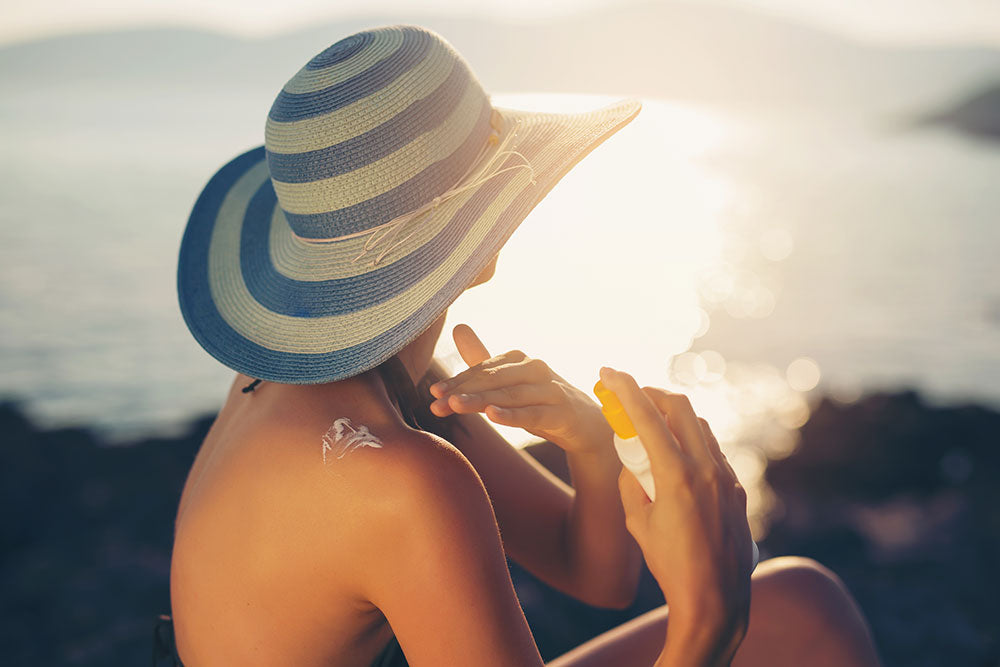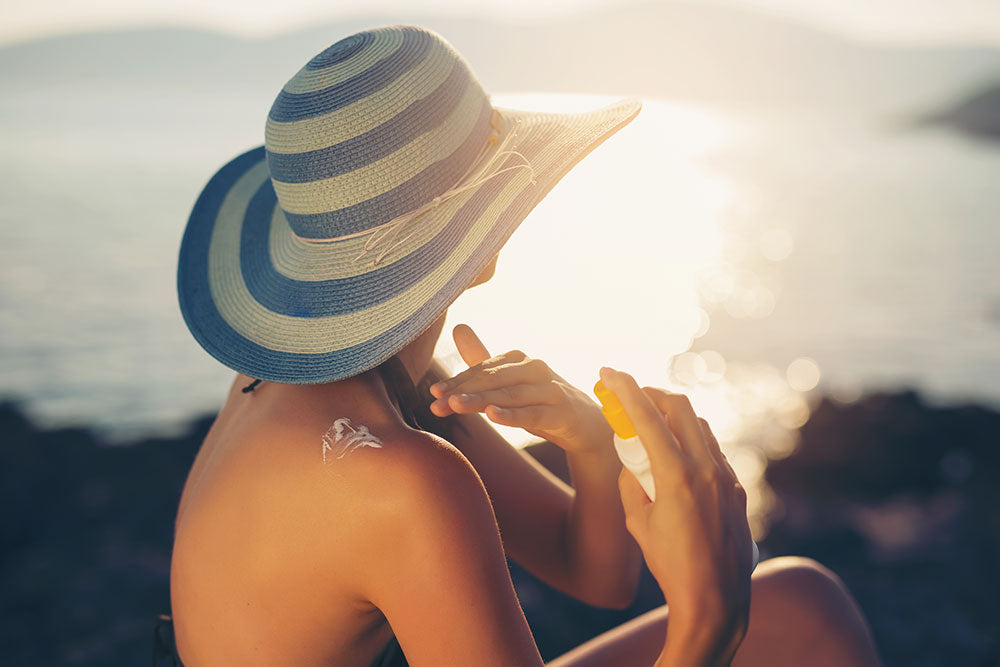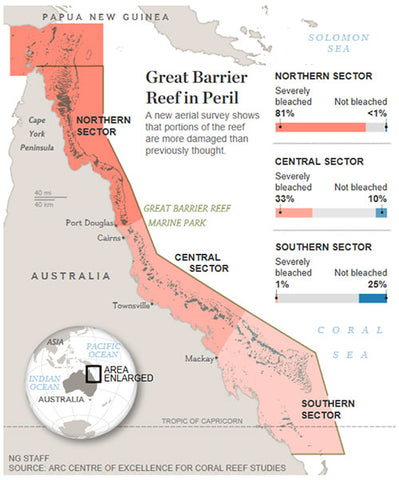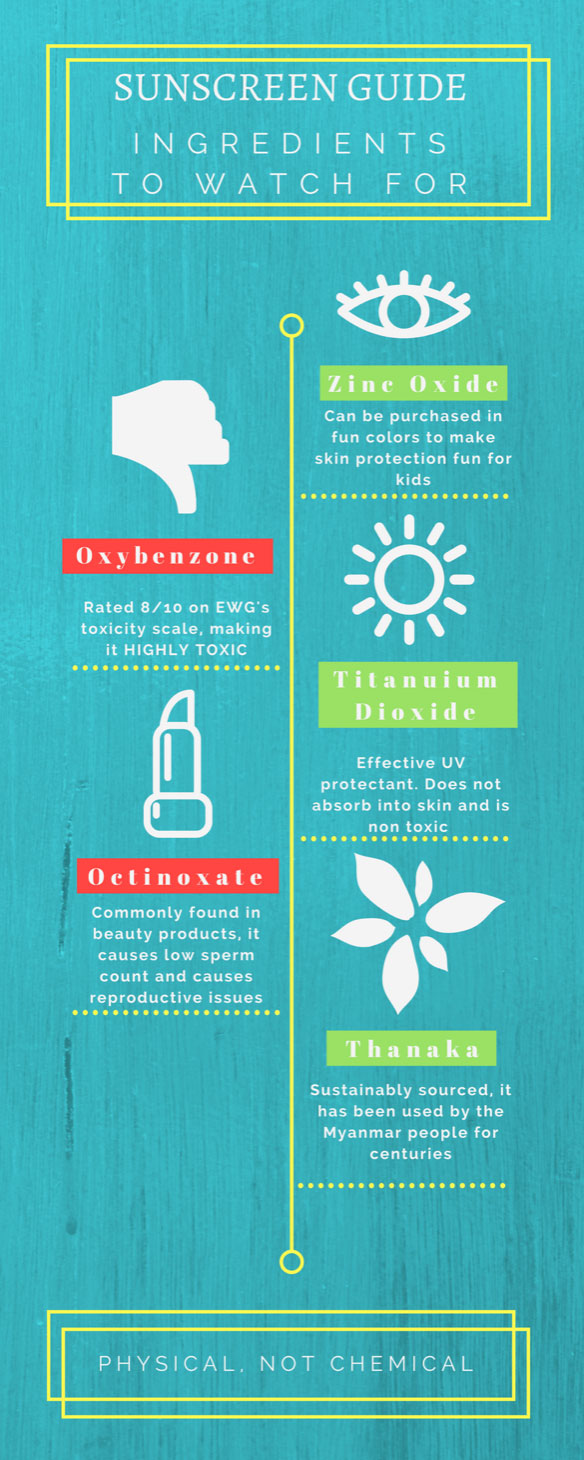Oxybenzone & Octinoxate: The sunscreen active ingredients that harm more than protect.


by Sabrina Laut
It’s that white goop that rubs in clear to protect us from the sun: chemical sunscreen.
Seemingly a genius in a tube, this white lotion promises to be invisible on skin and protect our skin from aging and sun damage.
What is in this magic sauce, and are there any side effects to purchasing these packages of protection?
*****
There are two different types of sunscreens, chemical-based sunscreens, and physical sunscreens.
Chemical sunscreens rub in clear and absorb the sun’s UV rays when they come in contact with skin. Physical sunscreens have UV filters that deflect, scatter, or block the sun’s rays.
While physical sunscreens usually use a combination of zinc oxide or titanium dioxide as their active ingredients, chemical sunscreens use a combination of usually two or more of oxybenzone, avobenzone, octisalate, octocrylene, homosalate, and octinoxate.
According to the Environmental Working Group (EWG), the FDA has not reviewed the toxicity of active ingredients in chemical sunscreens. Instead, these ingredients were grandfathered in when the FDA began considering sunscreen safety in 1978. This means that although some of these ingredients are considered toxic, they are still allowed in our sunscreens.
Seems like it might be time to revisit testing these ingredients, right? It is 2018 after all.
Let's take a look at two of the most common active chemical ingredients: Oxybenzone and Octinoxate.
OXYBENZONE
This active ingredient can be found in 65% of chemical sunscreens and has been determined to be the most toxic ingredient commonly found in sunscreens. (Rodriguez 2006) The EWG gave this chemical a rating of 8 out of 10 in terms of toxicity, meaning it is a high hazard. Yikes!!
Oxybenzone is easily absorbed through the skin, and in fact, has been found to have one of the highest penetration percentages at 1%-9%. It is known to interfere with cellular signaling, which can cause mutations and cell death (Hanson 2006) and has also been found to cause hormonal disruptions by mimicking estrogen, and commonly instigates allergic reactions.
Some have suggested that pregnant women and teenage boys should avoid this ingredient. The Center for Disease Control and Prevention did a study on a representative sample of children and adults in the United States and found oxybenzone in 96% of people tested. (Calafat 2008) This means that this product has been seen to accumulate in the bodies of humans long after the sunscreen washes off.
It seems pretty obvious that you may consider avoiding this chemical due to its high rates of hormone mimicry, cellular disruption, and allergic reactions.
OCTINOXATE
Another harmful yet very common ingredient, Octinoxate, also causes hormone disruption and allergic reactions. There is strong evidence that it is a human endocrine disruptor, mimicking estrogen and disrupting the thyroid function. (European Union 2007) Yet a number of so-called "organic" or even "natural" sunscreens are still including this into their formula. Go figure?!!
Traces of this substances have been found in urine, blood, and mothers’ breast milk, and it is recommended that women use mineral, or physical sunscreen when pregnant.
Octinoxate has been shown to cause both reproductive and developmental effects on animals that have been tested in moderate doses. (Klammer 2007) Being exposed to this ingredient has resulted in a reduction of sperm count in males at all dose levels, and significantly lowers estradiol and progesterone levels in females, which can be associated with infertility and miscarriages. (Axelstad 2011)
Due to these reasons, it is recommended to avoid Octinoxate in hair color products, sunscreens, and nail polishes.
WHAT THIS MEANS FOR OUR OCEANS
While human health is always at the forefront of concern when designing a product, the environment and our coral reefs should also be considered.
Up to 14,000 tons of sunscreen end up in coral reef areas every year. In that sunscreen slurry, oxybenzone and octinoxate both have been shown to cause coral bleaching, which ends up killing our coral reefs.
The presence of special algae is essential to the livelihood of coral. Because of the rising ocean temperatures and the introduction of chemical sunscreens, the algae are forced out of their coral-based homes. Without the algae, the coral cannot survive, and it dies, losing its vivid pigment. All that remains is a skeleton of white coral on the ocean floor. This process is called coral bleaching and is happening all across the globe.
In 2016, the Great Barrier Reef suffered the worst bleaching event on record, with about 30% of the coral dying. At the start of 2017, it was hit again, losing another 20%, leaving about half the coral cover dead. (Great Barrier Reef Marine Park Authority 2016)

Luckily, some people are taking notice and have begun to take action to mitigate the loss and potentially ban these chemical ingredients. This past year, Hawaii state senator Will Espero introduced a bill to ban all sunscreens containing Oxybenzone in the state, providing a very strong statement to sunscreen makers to find alternatives. The bill was dismissed and earlier this year, another bill was put to vote. The details of this are still up in the air, but Hawaiians remain hopeful that something positive will come out of it.
We know that these chemicals cause harm to both our bodies and to the environment, but what can we do?
ALTERNATIVES
Use a physical sunscreen, commonly referred to as a mineral based sunscreen. Ingredients to look for that have been approved by the FDA are: Zinc Oxide & Titanium Dioxide
In addition to zinc oxide, MANDA Organic Sun Paste uses thanaka, an ingredient sourced from the wood of a tree found in Myanmar. Not only has it been used as a sun protectant and beauty product by the people for thousands of years, it also is an environmentally sustainable way to source skin protection due to being a tree that is regenerative.
Additionally, be sure to find the shade, especially between 10 AM and 4 PM. You can also cover up with clothing, including a broad-brimmed hat and UV-blocking sunglasses. Be sure to get your skin checked by your doctor every year. And although these chemicals are common, they can be avoided. Opting to avoid oxybenzone and octinoxate.

REFERENCES
E. Rodriguez et al., Causal Agents of Photoallergic Contact Dermatitis Diagnosed in the National Institute of Dermatology of Colombia. Photodermatology, Photoimmunology & Photomedicine, 2006, 22(4):189-192.
A.M. Calafat et al., Concentration of the Sunscreen Agent, Benzophenone-3, in Residents of the United States: National Health and Nutrition Examination Survey 2003-2004. Environmental Health Perspectives, 2008, 116(7):893-897.
Hanson KM, Gratton E, Bardeen CJ. 2006. Sunscreen enhancement of UV-induced reactive oxygen species in the skin. Free Radic Biol Med 41(8): 1205-1212.
EU (European Union)- Strategy for Endocrine Disrupters 2007. Commision on endocrin disruption requested by the European Parliament in 1998.
e>Klammer H, Schlecht C, Wuttke W, Schmutzler C, Gotthardt I, Köhrle J, Jarry H. "Effects of a 5-day treatment with the UV-filter octyl-methoxycinnamate (OMC) on the function of the hypothalamo-pituitary-thyroid function in rats." Toxicology. 2007 Sep 5;238(2-3):192-9.
Axelstad, M., Boberg, J., Hougaard, K. S., Christiansen, S., Jacobsen, P. R., Mandrup, K. R., … & Hass, U. (2011). Effects of pre-and postnatal exposure to the UV-filter Octyl Methoxycinnamate (OMC) on the reproductive, auditory and neurological development of rat offspring. Toxicology and applied pharmacology, 250(3), 278-290.
http://elibrary.gbrmpa.gov.au/jspui/bitstream/11017/3206/1/Final-report-2016-coral-bleaching-GBR.pdf
https://www.nature. com/news/2008/080129/full/news.2008.537.html


